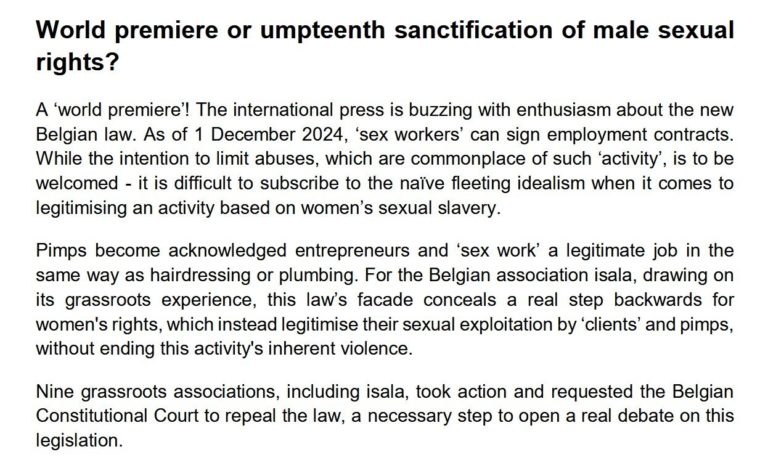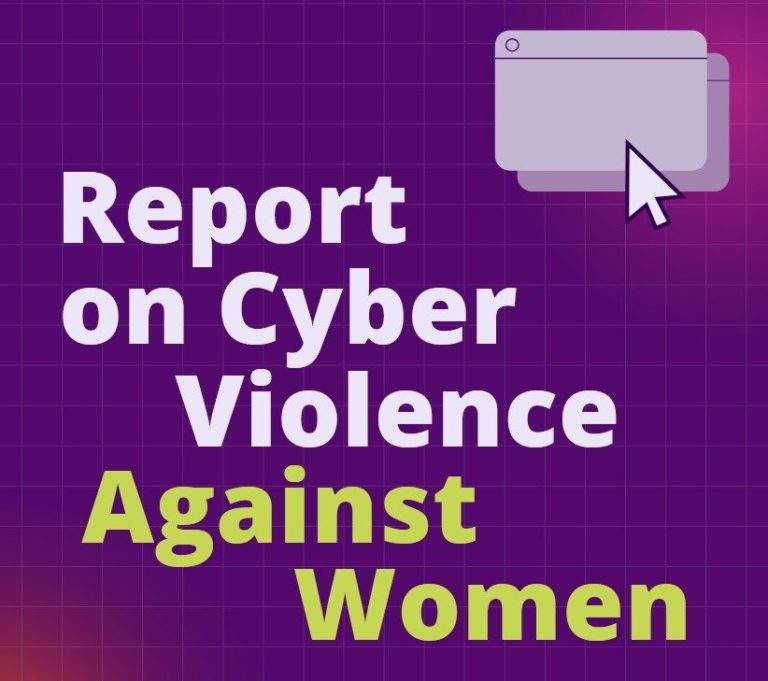From 25 November to 10 December, EuroMed Rights and its members will be marking the 16 days of activism against violence against women and girls by sharing stories and testimonies from feminist activists. Read Asha’s contribution to the “Speaking out against cyber violence” segment.
The original version of this article was published on euromedrights.org EuroMed Rights: Could you tell us more about the #HerNetHerRights campaign? Asha Allen: The #HerNetHerRights Campaign began in 2017 as a six-month project that analysed the state of online violence against women and girls in Europe. This resulted in an extensive report, resource pack and international conference that brought together diverse actors from across Europe to come up with innovative solutions and policy recommendations. Our work proved to be both timely and influential, becoming a reference document for reports of the European Parliament, UN Special Rapporteur on Violence against Women and in raising the issue high on the political agenda. From this initial project came #HerNetHerRights II: Prevent, Protect, Promote, a digital safety and violence against women training as part of EWL’s wider 2019 50/50 European elections campaign. Violence against politically engaged women remains a critical issue; 47% of women politicians have received death threats and women’s human rights defenders are at increased risk of psychological violence. Therefore, the training aimed to contextualise and provide practical support against the violence experienced online as politically engaged women. It included experimenting with practical digital safety tools and equipped participants with knowledge and analysis so that they could become champions of legislative change in their political careers, as so many had already foreseen. Throughout the 50/50 campaign and beyond, EWL members from Austria, Bulgaria, Finland, Italy, Romania and Turkey, as well as the EWL Secretariat trained nearly 500 politically engaged women including MEP candidates, local councillors and political youth parties. In the framework of the HerNetHerRights’ campaign, you organised trainings for women politicians before the last EU Parliament’s elections. Had they been victims of violence online? Unfortunately, the majority of the participants in our sessions had experienced some form of online violence and that is because so many women in politics face this reality. It became clear very quickly that the safe space we created for our trainings, based on feminist principles of solidarity and trust, were essential. Several participants shared their experiences, some only doing so openly for the first time which had a profound impact on all participants and trainers. What was also apparent was that women politicians from the national or European level who experienced online violence were not the only ones exposed; whether it was their assistants or communications employees, the violence and harassment directed at them was experienced by their colleagues as well. What forms of violence were most common? From sexist hate speech to doxing, from death/rape threats to imaged based sexual abuse through the use of deep fakes (the latter of which was used to expressly depict women politicians in sexually violent situations), the experiences varied and this only reinforced our original analysis on forms of violence against women online as well as digitally facilitated violence. For women experiencing intersecting forms of discrimination was much worse; black women are 84% more likely to receive abusive tweets and this was apparent during the campaign as it aligned with general elections in several countries, where many women politicians from ethnic minority backgrounds were sharing similar experiences. It was clear that what was occurring in the online space was a continuation of the misogyny and violence women faced offline; online violence is part of the continuum of violence against women and girls, it is not a separate phenomenon and in order to understand women’s experiences, it is vital that this holistic perspective is understood. What impact did it have on them? I speak in broad terms to respect the safety of the spaces that we created. The impact of online violence on those experiencing it can be severe and this was seen throughout the campaign and beyond; many women and girls experience trauma and serious impacts on their mental & physical health, particularly when taking into consideration that the risk of retraumatisation is incredibly high as instances of online violence can be so easily disseminated, reshared or perpetrated with ease. What was also apparent was how common it was for cases in which violence and sexual harassment which started online, quickly became incidences of physical and psychological violence. This is why it’s so vital to understand the impact of online violence against women and girls comprehensively. And on their political career? The diversity of participants we had within our trainings meant that we engaged with many women who were at different stages in their political careers. For politically engaged women, many face the reality of being excluded or being told to remove themselves from the digital space altogether, which is of detriment to their political engagement and careers. Women politicians should not have to accept violence as part of their professional reality and should not be forced to choose between their safety and ambitions to make a political contribution within their communities. During the campaign, we also came across several young women who were just beginning to express their political ambitions and were already considering whether to continue or not because quite simply the reality they face is that of harassment and violence. As the European Institute of Gender Equality noted in their research from 2019, 51% of young women in Europe are now too hesitant to engage in political debate online. Europe still has a long way to go in achieving parity or representative parliaments and this issue threatened to roll back any progress that has been made so far. How were they navigating online spaces? The knowledge and level of personal management of online political presence within our trainings very much reflected that of Europe; wide ranging in terms of how the space was navigated but the result remaining the same- experiencing some level of violence or harassment. Feedback we received indicated that the lack of uniformity across platforms on how to deal with instances of online violence made any reporting processes much more difficult to navigate. Often, women users find that reported incidences don’t reach the threshold for what qualifies as a violation of internal rules; which gives a striking indication of the lack of feminist perspective and human rights approach to the development of these tech platform standards. This essentially raises another question; how do women and girls navigate an online space takes a gender-neutral approach to safety despite evidence to the contrary? At EU level, what do you think is missing to properly address gender-based violence online? The EU lacks a comprehensive framework in order to prevent and combat violence against women including those perpetrated online or facilitated by digital tools. The EU has yet to ratify the Council of Europe Istanbul Convention and there remains a lack of cohesion between existing mechanisms such as the Victims rights Directive to adequately address the issue. For EWL, it is clear that the EU must adopt a comprehensive action plan to combat all forms of violence against women and girls; that includes a Directive and express recognition of the online dimension within this framework. Online violence must be defined, with the gendered dimension recognised and measures must be taken by all stakeholders including internet platforms, to eradicate violence against women online. At the national level, what do you think is missing to properly address gender-based violence online? Similar to the European level, there is a clear lack of uniformity when it comes to addressing online violence against women. Some countries have adopted measures to combat some specific forms of online violence such as imaged based sexual abuse within their criminal codes. However, others have taken a more holistic approach by recognising the online dimension in cases of harassment, intimate partner violence, stalking and sexual violence. Even these measures however do not go far enough and without the training of law enforcement and judiciary officials, effective implementation of these measures are not being experienced by the women and girls they are intended to protect. It also results in women across Europe experiencing different levels of protection or prevention, which must be rectified. What are the legal-political challenges you see in addressing cyberviolence against women? If online violence is not recognised through the holistic lens we have talked about, then legal-political measures will simply not have an impact. Sexist hate speech for example is not the only form of online violence women, particularly women politicians, face in the online space. Tackling online violence in many cases can also be conducted through existing legal frameworks, but unfortunately, because it is treated as a separate phenomenon, many are not aware of their existing rights to justice or law enforcement are not aware of the protections they can already legally provide. Online violence needs to be expressly defined from a legal standpoint as well; thus far examples of a legal definition have been minimal and there is a lack of consensus. Despite becoming more prominent on the international political agenda, the severity and socio-cultural impact of online violence has had on women and girls over the last few years is only now being recognised. What do you respond when told that stricter hate-speech rules on social media are jeopardising freedom of expression? Sexist hate speech is of course a vital issue and in the case of women in politics, it is one of the most common forms of online violence that they experience. Similarly, freedom of expression is also vital; the #MeToo movement conceptualised by Tarana Burke, benefitted from the freedom principles of the internet and gave a space for survivors to share their experiences anonymously. However, freedom of expression simply cannot be prioritised over the right to be free from all forms of violence and this is our primary objective when it comes to this issue. Similarly though, platforms should not be the only stakeholder determining what qualifies as harmful content, especially as the measures and content moderation rules currently implemented simply do not protect women from the levels of violence they consistently face. All stakeholders, including civil society need to come together to develop practical and policy based solutions that prioritises women’s safety, encourages digital citizenship and protects freedom of expression- it does not have to be a case of one of these elements being sacrificed for another. Do you have any example of good practices with regards to online GBV? There are many great resources developed by brilliant feminist activists aimed at improving the online space and digital safety training, that we recommend alongside our Resource Pack and Report: Glitch UK Take Back the Tech Feminist Internet HeartMob




